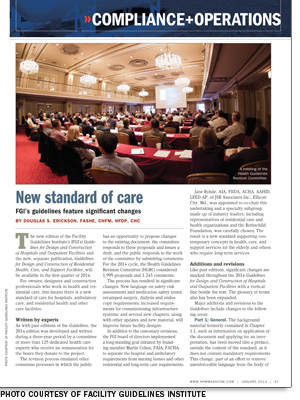
The new edition of the Facility Guidelines Institute's (FGI's) Guidelines for Design and Construction of Hospitals and Outpatient Facilities and the new, separate publication, Guidelines for Design and Construction of Residential Health, Care, and Support Facilities, will be available in the first quarter of 2014.
For owners, designers and construction professionals who work in health and residential care, this means there is a new standard of care for hospitals, ambulatory care, and residential health and other care facilities.
Written by experts
As with past editions of the Guidelines, the 2014 edition was developed and written during a three-year period by a committee of more than 125 dedicated health care experts who receive no remuneration for the hours they donate to the project.
The revision process emulated other consensus processes in which the public has an opportunity to propose changes to the existing document, the committee responds to these proposals and issues a draft, and the public responds to the work of the committee by submitting comments. For the 2014 cycle, the Health Guidelines Revision Committee (HGRC) considered 1,995 proposals and 1,243 comments.
The process has resulted in significant changes. New language on safety risk assessments and medication safety zones; revamped surgery, dialysis and endoscopy requirements; increased requirements for commissioning infrastructure systems; and several new chapters, along with other updates and new material, will improve future facility designs.
In addition to the customary revisions, the FGI board of directors implemented a long-standing goal initiated by founding member Martin Cohen, FAIA, FACHA, to separate the hospital and ambulatory requirements from nursing homes and other residential and long-term care requirements.
Jane Rohde, AIA, FIIDA, ACHA, AAHID, LEED AP, of JSR Associates Inc., Ellicott City, Md., was appointed to co-chair this undertaking and a specialty subgroup made up of industry leaders, including representatives of residential care and health organizations and the Rothschild Foundation, was carefully chosen. The result is a new standard supporting contemporary concepts in health, care, and support services for the elderly and others who require long-term services.
Additions and revisions
Like past editions, significant changes are marked throughout the 2014 Guidelines for Design and Construction of Hospitals and Outpatient Facilities with a vertical line beside the text. The glossary of terms also has been expanded.
Major additions and revisions to the Guidelines include changes to the following areas:
Part 1: General. The background material formerly contained in Chapter 1.1, such as information on application of the document and applying for an interpretation, has been moved into a preface, outside the content of the standard, as it does not contain mandatory requirements. This change, part of an effort to remove unenforceable language from the body of the text, will help national and state organizations adopt Part 1 of the 2014 edition. The change was motivated by an International Code Council review of sections of the Guidelines for potential adoption into the 2015 "I-Codes."
• New versus renovation. Noteworthy changes have been made to improve the application of the Guidelines to existing facilities. Only altered, renovated or modernized portions of an existing building system or an individual component is required to meet the installation and equipment requirements in the Guidelines. A list of exceptions has been added to help clarify when existing systems or building equipment must be updated.
• Functional program. The HGRC was challenged by the American Institute of Architects Academy of Architecture for Health and the American Society for Healthcare Engineering (ASHE) to consider whether the functional program is a minimum requirement and should be removed from the document or moved to the appendix. Under the leadership of Ken Cates, CHC, of Northstar Management Co. LLC, St. Louis, a task group thoroughly reviewed the long-standing requirement for a functional program and recommended it be retained.
FGI and HGRC leaders agreed the functional program is a critical aspect of planning and designing health care and residential facilities and mandated its inclusion in the 2014 Guidelines documents. Revisions were made, however, including elimination of more than 400 references to the functional program in the body of the Guidelines for Design and Construction of Hospitals and Outpatient Facilities. Additionally, the functional program requirements were streamlined by moving substantial material into the appendix, adding a requirement for an executive summary of key elements, and separating the environment of care considerations from the functional program requirement.
• Safety risk assessment. Of all the changes in the 2014 Guidelines, the most overarching is the development of the safety risk assessment (SRA), which incorporates the existing infection control and patient handling and movement assessments in Chapter 1.2. Under the leadership of Ellen Taylor, AIA, EDAC, of the Center for Health Design, a task group worked to streamline a risk identification process with considerations for infection control, patient handling and movement, fall prevention, medication safety, behavioral health, patient safety, immobility prevention and security.
The purpose of the owner-driven SRA is to foster a proactive approach to patient and caregiver safety by mitigating risks from the physical environment that could directly or indirectly contribute to harm. Health care reform has brought a shift in attention from volume-based services to performance-based outcomes, including patient safety outcomes. The developers of the Guidelines have taken this proactive approach to safety outcomes rather than leaving owners to address adverse events in hindsight through expensive retrofits.
Part 2: Hospitals. New and significantly revised language in Chapter 2.1, Common Elements for Hospitals, includes:
- Appendix language on staff rest areas;
- A completely revised section on food and nutrition facilities;
- Appendix language on designing to enhance opportunities for patient ambulation and mobility;
- Expanded appendix material on the characteristics and criteria for selecting surface materials;
- Patient night-lighting recommendations;
- A requirement to place electronic health record systems on an uninterruptible power supply;
- Cooling for technology equipment rooms must be on emergency power;
- Elevator cab size clear dimensions of 5 feet, 8 inches wide by 9 feet deep.
Another significant new change is the concept of the medication safety zone. Eileen Malone, R.N., EDAC, of Mercury Healthcare Consulting LLC, Alexandria, Va., worked with a focus group on hospital nursing units to incorporate this essential new aspect of patient care, based on material from the U.S. Pharmacopeial Convention, into the Guidelines.
The 2014 edition provides a framework for a predesign medication safety risk assessment and minimum design requirements (with supporting appendix language) to guide design and construction of medication safety zones across the continuum of care with the goal of supporting safe medication use systems.
New and significantly revised language in Chapter 2.2, Specific Requirements for General Hospitals, includes:
- New children's hospital chapter addressing the special needs of general acute pediatric care;
- New critical access hospital chapter addressing the needs of these small facilities;
- New language on family zone support features;
- Clarification of requirements for the critical care patient toilet or human waste disposal room;
- A requirement for built-in mechanical lifts in all newly constructed bariatric nursing unit rooms (10 percent of the rooms in renovation projects);
- Broadened requirements for observation units, allowing location outside the emergency department;
- New requirements and appendix language for hybrid operating rooms;
- Revisions and additions to the imaging services section (e.g., magnetic resonance imaging, gamma camera, positron emission tomography and proton therapy).
Part 2: Hospitals and Part 3: Outpatient Facilities. New and significantly revised language that affects both hospitals and outpatient facilities includes:
- Guidance on locating hand-washing stations serving multiple patient care stations;
- Appendix language on placing emergency equipment in egress corridors;
- Clarification that room size for a single-bed exam room must accommodate placement of the exam station at a 45-degree angle, although, in practice, placement against the wall is permitted;
- Unsealed (open) water features are no longer permitted inside a hospital or in a licensed outpatient health care occupancy area;
- The surgical suite has two designated areas — semirestricted and restricted;
- Location of scrub stations in surgical suites next to the entrance to the operating room required, but two scrub positions at one station can serve two operating rooms as long as the station is next to the entrance of each;
- No requirement for a substerile room between every two operating rooms;
- Revised facility requirements for sterilization processes conducted in the surgical suite;
- A minimum of 1.5 post-anesthesia care unit stations per operating room;
- Pre- and post-op space and clearance requirements modified for consistency;
- No requirement for a door to a staff changing area or lounge to open directly into the semirestricted area of the surgical suite; the new requirement states only that a staff changing area and lounge must be provided, which allows these functions to be shared with another department;
- New provisions for electroconvulsive therapy facilities;
- Revised endoscopy instrument processing room requirements;
- Updated content on freestanding emergency facilities;
- Corridor widths per applicable building codes.
Part 3: Outpatient Facilities. By far, the most significant change in outpatient facility requirements is the revision to requirements for operating rooms (ORs) and support areas in surgical facilities.
This effort was undertaken by a small group led by Byron Burlingame, R.N., CNOR, of the Association of periOperative Registered Nurses. These changes in OR requirements have been a long time coming as surgical procedures previously performed primarily in an inpatient setting are increasingly taking place in outpatient facilities.
New definitions have been provided for invasive procedures, procedure room, and the two areas that make up the surgical suite — semirestricted and restricted areas. These definitions are the foundation for the changes in the body of the document, especially the distinction between an operating room and a procedure room in the ambulatory surgery setting. The decision was made to move away from the outdated Class A to C levels based on anesthesia use. Instead, a one-size minimum requirement was developed for an outpatient operating room (formerly the Class B and Class C rooms).
The minimum size for an ambulatory OR was calculated to be 250 square feet, and recommendations for ORs that may need to be larger are included in the appendix. The former Class A operating room is now termed a procedure room, which is a room designated for the performance of procedures that are not defined as invasive and may be performed outside the restricted area of a surgical suite, but may require use of sterile instruments or supplies.
Other notable changes in Part 3 include:
- Revised chapter on primary care centers;
- Modified cancer treatment area size and configuration requirements;
- Chapter 3.8 has been changed to focus on office-based procedure and operating rooms;
- New chapter on dental facilities.
Part 4: Standard 170: Ventilation of Health Care Facilities. FGI continues to work with ASHRAE and ASHE to produce this American National Standards Institute reference.
ASHRAE Standard 170 is under a continuous maintenance process, which permits official changes to be made over the life cycle of the document. To date, more than 20 official modifications have been made to the 2008 edition of ASHRAE Standard 170, which is a formal part of the 2010 Guidelines.
These addenda can be viewed on the ASHRAE website at www.ashrae.org/standards-research--technology/standards-addenda or the FGI website at www.fgiGuidelines.org.
At the time of this writing, ASHRAE was working on a 2013 edition to Standard 170 to be released in December 2013 and incorporated into both the 2014 Guidelines standards.
Make a difference
In preparation for the 2018 revision cycle, which will begin next year, health care design professionals, owners and clinicians are encouraged to contact FGI with recommended changes and suggestions for new subjects to be covered as well as to get ready to submit proposals.
Douglas S. Erickson, FASHE, CHFM, HFDP, CHC, is president of TME Inc., Little Rock, Ark.; CEO of the Facility Guidelines Institute; and Health Guidelines Revision Committee chair of the 2010, 2014 and 2018 Guidelines revision cycles. He can be reached at doug@fgiGuidelines.org or derickson@tmecorp.com.
Sidebar - New publication targets residential facilities
Sidebar - List of exceptions to requirements in new Guidelines





